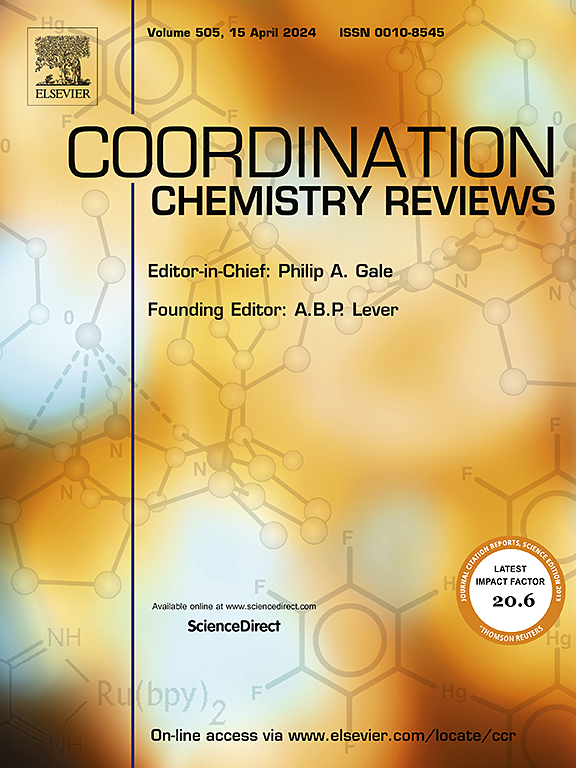Charge transfer in hybrid quantum dot / metal-organic framework systems: Current understanding and future challenges
IF 23.5
1区 化学
Q1 CHEMISTRY, INORGANIC & NUCLEAR
引用次数: 0
Abstract
Hybrid materials combining the optoelectronic absorption and tunability of quantum dots (QDs) with the high surface area, chemical functionality, and porosity of metal-organic frameworks (MOFs) are emerging as systems with unique optoelectronic properties relevant to applications in catalysis, sensing, and energy conversion and storage. A key component of the electronic interaction between QDs and MOFs is the transfer of charge between the two materials. This review examines the mechanisms driving charge transfer at the QD/MOF interfaces and the effects that both physical and chemical composition have on this process. We provide an overview of the key experimental approaches, including spectroscopic and electrochemical techniques, which have been used for probing charge transfer dynamics in this hybrid system. Challenges in controlling interfacial structure, distinguishing between charge and energy transfer, and optimizing stability are also discussed. This review highlights recent work on the preparation and characterization of QD/MOF hybrid materials, as well as fundamental studies advancing the understanding of charge transfer processes that occur in these systems.


混合量子点/金属有机框架系统中的电荷转移:当前的理解和未来的挑战
结合量子点(QDs)的光电吸收和可调性与金属有机框架(MOFs)的高表面积、化学功能和孔隙率的混合材料正在成为具有独特光电性能的系统,与催化、传感、能量转换和存储等应用相关。量子点和mof之间电子相互作用的一个关键组成部分是两种材料之间的电荷转移。本文综述了驱动QD/MOF界面电荷转移的机制以及物理和化学成分对这一过程的影响。我们提供了关键的实验方法的概述,包括光谱和电化学技术,已用于探测这种混合系统中的电荷转移动力学。还讨论了在控制界面结构、区分电荷和能量转移以及优化稳定性方面所面临的挑战。本文重点介绍了QD/MOF杂化材料的制备和表征方面的最新工作,以及促进对这些系统中电荷转移过程理解的基础研究。
本文章由计算机程序翻译,如有差异,请以英文原文为准。
求助全文
约1分钟内获得全文
求助全文
来源期刊

Coordination Chemistry Reviews
化学-无机化学与核化学
CiteScore
34.30
自引率
5.30%
发文量
457
审稿时长
54 days
期刊介绍:
Coordination Chemistry Reviews offers rapid publication of review articles on current and significant topics in coordination chemistry, encompassing organometallic, supramolecular, theoretical, and bioinorganic chemistry. It also covers catalysis, materials chemistry, and metal-organic frameworks from a coordination chemistry perspective. Reviews summarize recent developments or discuss specific techniques, welcoming contributions from both established and emerging researchers.
The journal releases special issues on timely subjects, including those featuring contributions from specific regions or conferences. Occasional full-length book articles are also featured. Additionally, special volumes cover annual reviews of main group chemistry, transition metal group chemistry, and organometallic chemistry. These comprehensive reviews are vital resources for those engaged in coordination chemistry, further establishing Coordination Chemistry Reviews as a hub for insightful surveys in inorganic and physical inorganic chemistry.
 求助内容:
求助内容: 应助结果提醒方式:
应助结果提醒方式:


